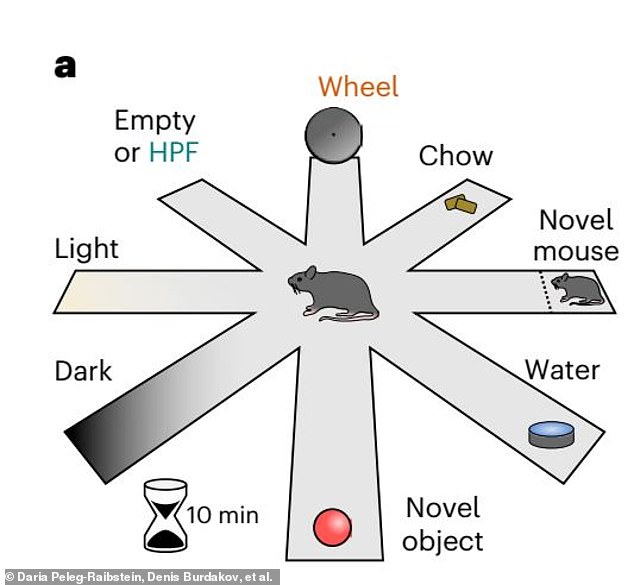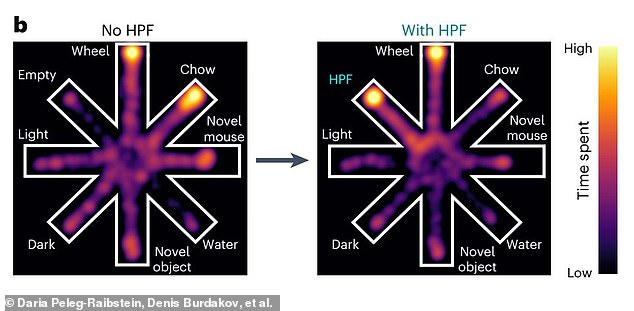Couch potatoes rejoice! Chemical discovered that makes us choose exercise over snacks — and it could pave the way for a pill that makes us want to hit the gym
Faced with the temptation of tasty snacks, it can seem impossible to get off the couch and hit the gym.
But there’s good news for couch potatoes: scientists have discovered the chemical that makes us choose exercise over fun.
A team of researchers from ETH Zurich discovered that a chemical in our brain called oxerine plays a crucial role in the decision to exercise.
In laboratory experiments, mice with a blocked oxerine system spent more time drinking a delicious milkshake and less time running on their wheel.
According to the researchers, this chemical should have the same effect in humans, potentially paving the way for a pill that makes us want to hit the gym.
Good news for couch potatoes, as researchers claim they’ve found the chemical that makes us choose exercise over snacking (stock image)
Many people around the world do not get the amount of exercise they need to stay healthy.
According to the World Health Organization, approximately 80 percent of adolescents and 27 percent of adults do not exercise enough.
Combined with the availability of high-calorie, highly processed foods, this has led to an ‘obesity epidemic’.
Professor Denis Burdakov says: ‘Despite these statistics, many people manage to resist the ever-present temptations and exercise sufficiently.
“We wanted to know what’s in our brains that helps us make these decisions.”
To understand how we can resist the temptation to sin, the researchers placed mice in a room with eight hallways leading to different options.

The researchers placed mice in a chamber with eight equidistant hallways. One hallway contained a running wheel (top) while another was either empty or contained a “Highly Palatable Food” (labeled HPF) in the form of a strawberry milkshake.
One of the choices was an exercise wheel and the other was either empty or contained “very tasty food” in the form of a strawberry milkshake.
Without any disruption to their neurochemistry, the mice divided their time between exercising and eating their normal “food” or the milkshake when it was introduced.
However, when the researchers blocked the oxerine system using a drug or genetic modification, the mice became significantly less interested in exercise.

As this heatmap shows, the mice spent less time eating their usual food when the milkshake was added (right), but spent the same amount of time exercising.
Compared with mice whose oxerine system was intact, the modified mice spent twice as much time at the milkshake bar and half the time exercising.
Interestingly, disrupting the mice’s oxerine metabolism had no effect on their behavior when they were placed in a chamber with a milkshake or a running wheel.
Professor Burdakov says: ‘This means that the primary role of the orexin system is not to determine how much the mice exercise or how much they eat. Rather, it seems to be crucial in making the decision between one option and the other, when both options are available.’
In the past, many researchers have attempted to explain our eating and exercise habits by looking at the brain chemical dopamine.

When the mice’s oxerine systems were inhibited, adding the strawberry milkshake caused the mice to spend much less time moving and more time eating. This graph shows where the mice spent most of their time
This chemical is crucial to our overall motivation, but it doesn’t necessarily help explain why we choose one thing over another.
“Our brains release dopamine when we eat and when we exercise, but that doesn’t explain why we choose one over the other,” says Professor Burdakov.
By isolating oxerine as a critical factor, the researchers hope to pave the way for treatments that could have a similar effect in humans.
Co-author Dr Daria Peleg-Raibstein said: ‘Understanding how the brain mediates the relationship between food consumption and physical activity may help us develop more effective strategies to address the global obesity epidemic and related metabolic disorders.’

The researchers believe that oxerine could be the key to ‘temptation-resistant voluntary exercise’ and could even treat people to help them choose exercise over food (stock image)
The researchers believe there is a good chance that a drug that blocks oxerine would have the same effect in humans as it does in mice.
Scientists have already discovered that about one in two thousand people has an impaired orexin system.
These people often also have narcolepsy. Therefore, oxerine-inhibiting drugs are also used to treat insomnia.
While the researchers behind this study remain focused on the basic neurochemistry of oxerine, they say further clinical trials are now possible.
Dr. Peleg-Raibstein adds: ‘The challenge now is to verify our results in humans.’
